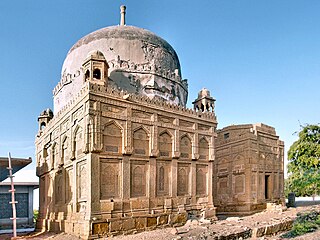Related Research Articles

Khairpur is a city and the capital of the Khairpur District of Pakistan's Sindh province.

Dadu, is a city and the capital of Dadu District in Sindh, Pakistan. The city is located on the western bank of River Indus and is administratively subdivided into four Union councils. Dadu is famous for its tea.

The Battle of Miani or Meeanee was a battle between forces of the Bombay Army of the East India Company, under the command of Charles Napier and the Baloch army of Talpur Amirs of Sindh, led by Mir Nasir Khan Talpur. The battle took place on 17 February 1843 at Miani, Sindh, in what is now modern-day Pakistan. This battle and the subsequent Battle of Hyderabad eventually led to the capture of parts of Sindh region, first territorial possession by the East India Company in what is the modern-day state of Pakistan.
The Kalhora or Kalhora Abbasi is a Sindhi Sammat clan in Sindh, Pakistan.
Mir Ali Murad Talpur, known as the Aadil-i-Jang, was the second ruler of the Mankani Talpur state of Mirpurkhas. He founded Mirpurkhas town in 1806 and made it the capital of his state which was founded by his father, Mir Tharo Khan Talpur at Keti Mir Tharo. His state included territories of the present day southeastern Sindh. His son, Mir Sher Muhammad Talpur waged a guerrilla campaign in Sindh against the East India Company after the British victory at the Battle of Hyderabad in February 1843, which resulted in Hyderabad falling under British control.

The Talpur Dynasty was a Baloch dynasty that ruled the Sind State after overthrowing the Kalhora dynasty in 1783 until British conquest of Sindh in 1843. A branch of the family continued to rule Khairpur, under British suzerainty and later as a Pakistani princely state, until 1955 when it was amalgamated into West Pakistan.
Mir Allahyar Talpur belonged to Mankani branch of the Talpur dynasty, which ruled Southeastern Sindh. He founded the town of Tando Allahyar. Remnants of his clay fort are still of interest to visitors. He "occupies a distinguished place in the annals of Talpur history for his contribution in the field of architecture, art and irrigation in Kachho (Dadu)." His tomb, built in 1731 is in Drigh Bala, along with others of the Talpurs. It features panels with battle scenes and men and women sitting and talking with their attendants.
Hyderābād City (Haidarābād), headquarters of the district of Sindh province of Pakistan traces its early history to Neroon, a Sindhi ruler of the area from whom the city derived its previous name, Neroon Kot. Its history dates back to medieval times, when Ganjo Takker, a nearby hilly tract, was used as a place of worship. Lying on the most northern hill of the Ganjo Takker ridge, just east of the river Indus, it is the third largest city in the province and the eighth largest in the country with an expanse over three hillocks part of the most northerly hills of the Ganjo Takker range, 32 miles east of the Indus with which it is connected by various routes leading to Gidu Bandar.
Mir Shahdad Jo Qubo,, is located in Shahpur Chakar (city) of the Sanghar District, in Sindh Province of southern Pakistan.

Khudabad is a city in Dadu District, Sindh, Pakistan. It served as capital of the Kalhora dynasty between 1719 and 1768, when the capital was shifted to Hyderabad.
Mehrabpur, (Sindhi:محرابپور), is a city in the Naushahro Feroze District in the Sindh province of Pakistan. The city is administratively subdivided into 8 Union Councils. It has a busy railway station on the main railway line between Karachi and Lahore. It is a junction station with a disused branch line to Naushahro Feroze.
The Battle of Halani was fought in 1783 between the Baloch tribe of Talpurs and the Kalhoro Dyansty near Halani village for the control of the Sindh region, in modern-day Pakistan. The Talpurs, led by Mir Fateh Ali Khan Talpur, won the battle over Mian Abdul Nabi Kalhoro of the Kalhora dynasty, and established the Talpur dynasty.

The Kalhora dynasty was a Sindhi Muslim Kalhora tribe dynasty based in the region of Sindh, present day Pakistan. The dynasty governed much of Sindh and parts of Kutch between 1701 and 1783 from their capital of Khudabad, before shifting to Hyderabad from 1768 onwards. They were assigned to hold authority by the Mughal Grand Vizier Mirza Ghazi Beg.

Tomb of Tharo Khan is the tomb of Tharo Khan Talpur, located in Mirpur Khas, in Sindh, Pakistan. The tomb is related to the Tombs of Talpur Mirs complex, built in the eighteenth century in the city of Hyderabad. The tombs are of the ruling Talpur Mirs of Sindh.

Mai Khairi was a Sindhi architect who was involved in the construction of various religious architecture during the Kalhora and Talpur dynasties in Sindh.

The Thatta Sarkar (1593–1629), Thatta Subah (1629–1737) or Sind State (1737–1843), also referred to as Scinde or Sindh, was a Mughal Sarkar later a Subah, then a proto-state, and lastly a princely state in the Sindh region of the Indian subcontinent until its annexation by the East India Company in 1843. The name Sind, now obsolete, was once the anglicized name of the state, which was also adopted by the British to refer to its division.
The siege of Karachi took place between Talpur Dynasty and Khanate of Kalat for control of Karachi between 1792 and 1795 ending with Talpur Victory.
The First Battle of Shikarpur took place between Kalhora Dynasty and Durrani Empire for succession of Mian Izatyar Kalhoro to the throne of Sindh.
Mir Shahdad Khan Talpur(Sindhi: مير شهداد خان ٽالپر), the great-grandfather of the first Talpur ruler, was an influential nobleman who held significant authority in Sindh long before the Talpur dynasty rose to power. His contributions to military, administrative, and agricultural development made him a pivotal figure during the Kalhoro and Mughal eras. Mian Yar Muhammad took him under his wing and later awarded him the title of "Barkhurdar", appointing him as the commander-in-chief of his army.
Mir Fateh Ali Khan Talpur was the first ruler of the Talpur dynasty in Sindh, a province in present-day Pakistan. He played a critical role in the transition of power from the Kalhora dynasty to the Talpur dynasty. His reign marked a period of political stability, territorial reclamation and cultural patronage in Sindh.
References
- ↑ "Historical Background of Talpur Mirs of Sindh - The Royal Talpurs and the Heritage of Sindh" . Retrieved 2024-11-25.
- ↑ "The crumbling Kalhora necropolis in Sindh". The Friday Times. May 10, 2013. Archived from the original on August 9, 2013. Retrieved July 3, 2014.